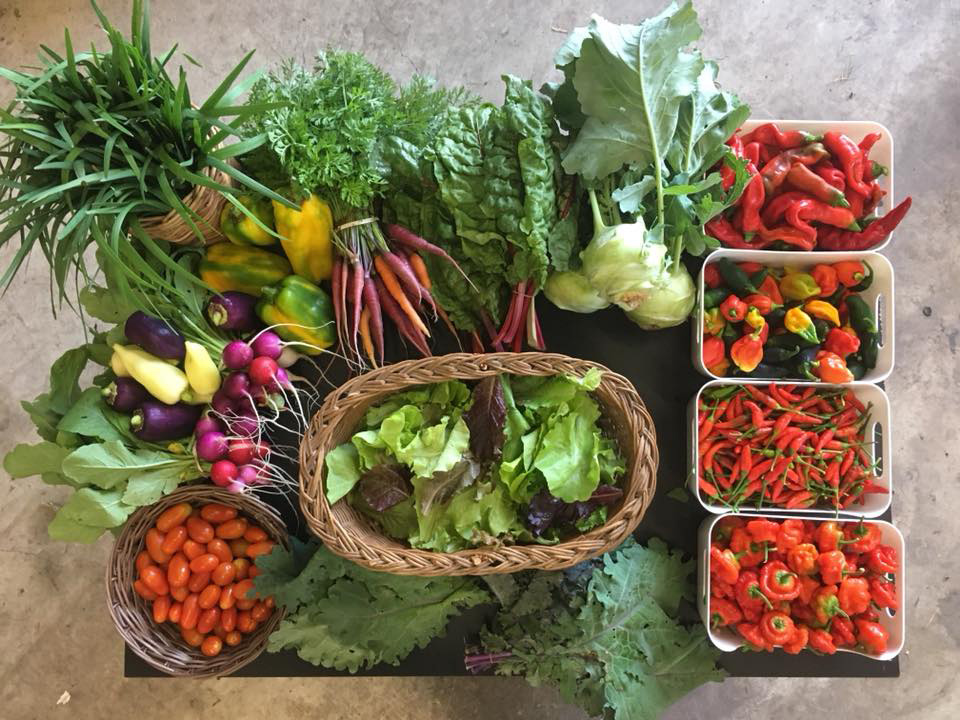Follow organic gardening practices long enough, and eventually you encounter the term “permaculture.” The word, a contraction of permanent and agriculture, reflects a guiding approach that combines the best practices from natural landscaping and edible gardening. A permaculture system goes beyond the organic garden with use of sustainable energies and resources like solar power, extensive recycling and even efficient home design to
minimize impact on the surrounding environment.
Sarah and Sylvain Clavieres have been practicing sustainable agriculture at Talking Tree Farm in Converse on less than 2 acres since 2015. Their permaculture practices include running the farm on 100-percent solar energy, raising animals, incorporating multiple ponds into the farm’s operation and saving seeds from heirloom plants. Despite its compact size, Talking Tree Farm is productive enough for a produce booth at the Pearl Brewery weekend farmers market.
Sarah defines permaculture as a way for the couple to grow food in a sustainable way that is healthy, not just for themselves but for the environment. “Nature really ultimately does most of the work for us,” she said. “It’s more than farming — it’s a lifestyle.”
Talking Tree Farm offers free monthly permaculture classes that are helpful for those looking to learn how to start a garden or how to use sustainable techniques in an existing garden. The couple share their expertise for beginners with sign-ups for their classes on the farm’s Facebook page.
For most home gardeners, a solar-powered home with water collection system, 100-percent waste recycling and enough land to feed the homeowners may be unattainable. A first step for many homeowners is to transform their front lawns from water-hungry grass to native plants and other hardy perennials. Talking Tree Farm offers edible landscape design consulting for those who want to transform their home lawns into a miniature “food forest” capable of producing crops while minimizing environmental impact.
If that is too drastic a step, there are simple permaculture practices accessible to the typical home gardener. Here are five to use in your backyard.
Permaculture
Practices For The Home Garden
1 Choose native plants or those that are well adapted to your locale. Native plants are adapted for our climate and fare better, typically needing less water. Look for and plant food sources that are adapted for the environment and benefit the landscape in some way. Fruit trees can provide food and shade, while herbs can be used to season food and feed bees and other pollinators. The toughest, most adapted plants that produce fruit for our area include Oriental persimmon, pomegranate, blackberries and figs.
2 Copy natural patterns from the local environment and reproduce as much as possible in your landscape. If you look at natural landscapes across San Antonio, you will notice plants because they are closer to water sources or are native plants able to tap into the water table deep in the soil. Home gardens share those same needs for successful water management. Consider replacing thirsty grass with native plants adapted to our dry, hot summers. If possible, collect rainwater for watering plants. Try to contour land so it retains water better when it does rain, rather than running off. There are many online resources that describe ways to shape your land to divert water for maximum soil absorption.
3 Group plants into meaningful collections. Natural landscapes are rarely a monoculture of one plant type, a common practice in modern agriculture. Permaculture groups plants with compatible roots and shapes into plantings where they can happily grow together. Companion planting — growing plants side by side to encourage each other’s growth — is one aspect. Also think about grouping plants with similar needs, and visualize how they will look at mature heights. You want to make sure you can reach around larger plants to harvest from smaller ones.
4 Identify microclimates in your yard and divide the space into zones based on use. Every landscape has microclimates. In the cooler, shady corners think of plants that would appreciate a respite from the unrelenting summer afternoon heat. Plants that might freeze if exposed to cold winds could survive if located in sheltered spots that get full sun. Place heavily used features, such as an herb garden, in the most accessible areas closest to your home.
5 Build the soil as much as possible. Good compost supplies both organic matter for soil building and fertilizer for crops and supports beneficial biological activity for your plants. Instead of using chemical fertilizers, choose natural methods of enriching the soil, such as making your own compost or bringing it into your garden. When using mulch, select ones like chopped leaves that break down and add organic matter to the soil.
Resources:
For more information about permaculture, please visit The Permaculture Research Institute www.permaculturenews.org.
More information about other permaculture sites in San Antonio: www.permagora.com/home/2017/8/2/san-antonio-permaculture-tour.
Talking Tree Farm: http://talkingtreefarm.com/.
Building rich soil using permaculture methods: https://permacultureapprentice.com/building-soil/.
By Iris Gonzalez
Photos courtesy of Talking Tree Farm











0 Comments